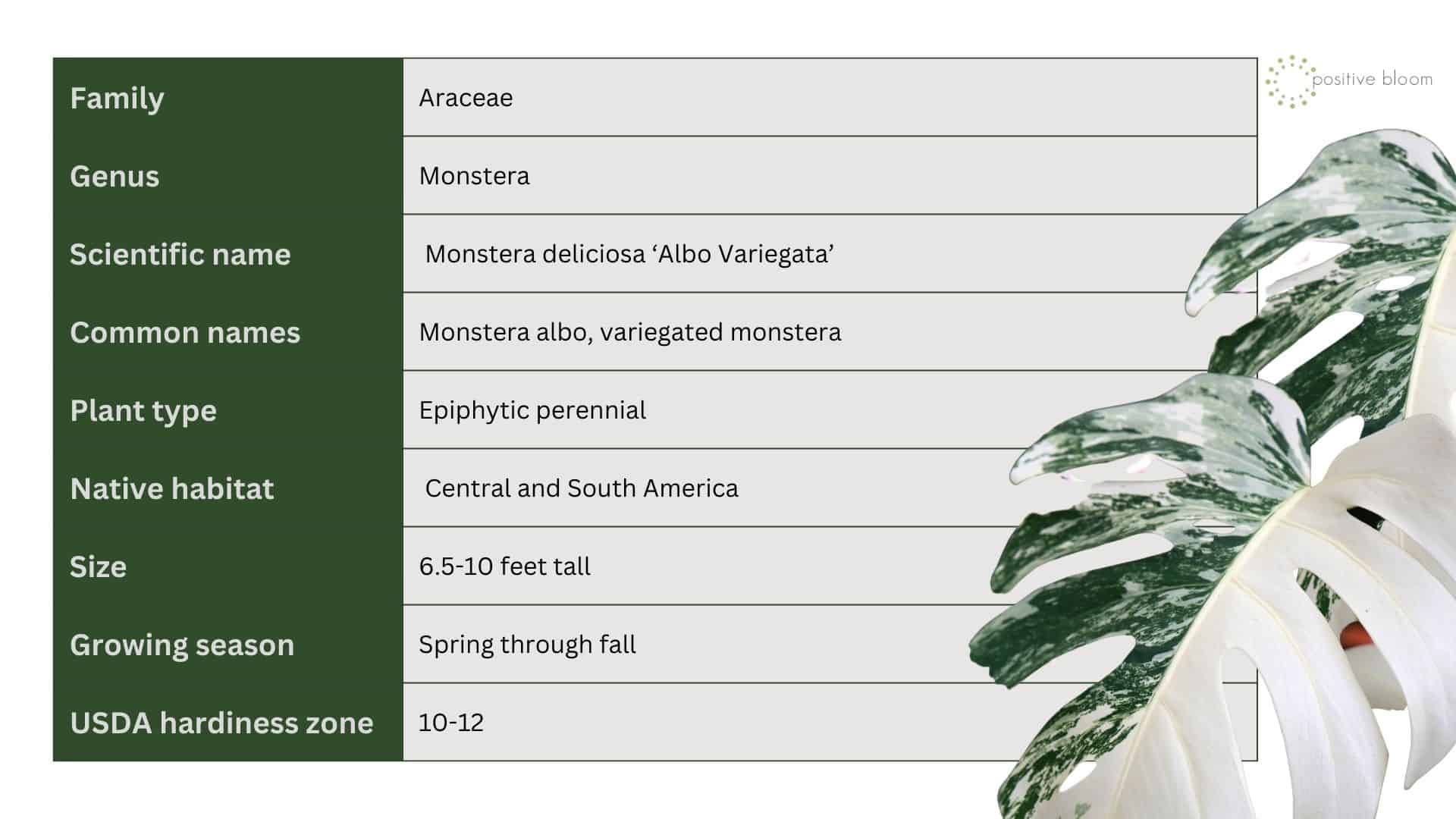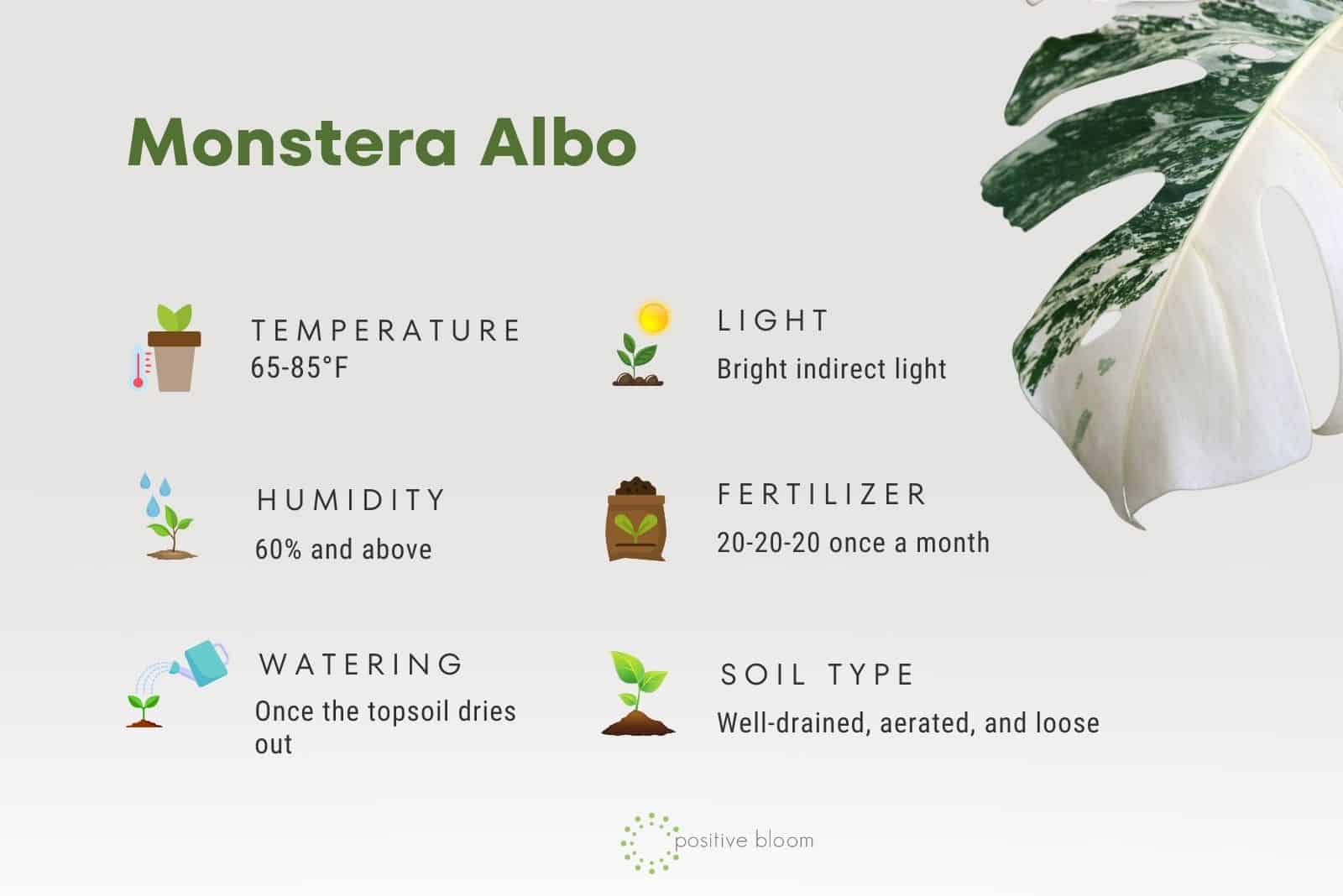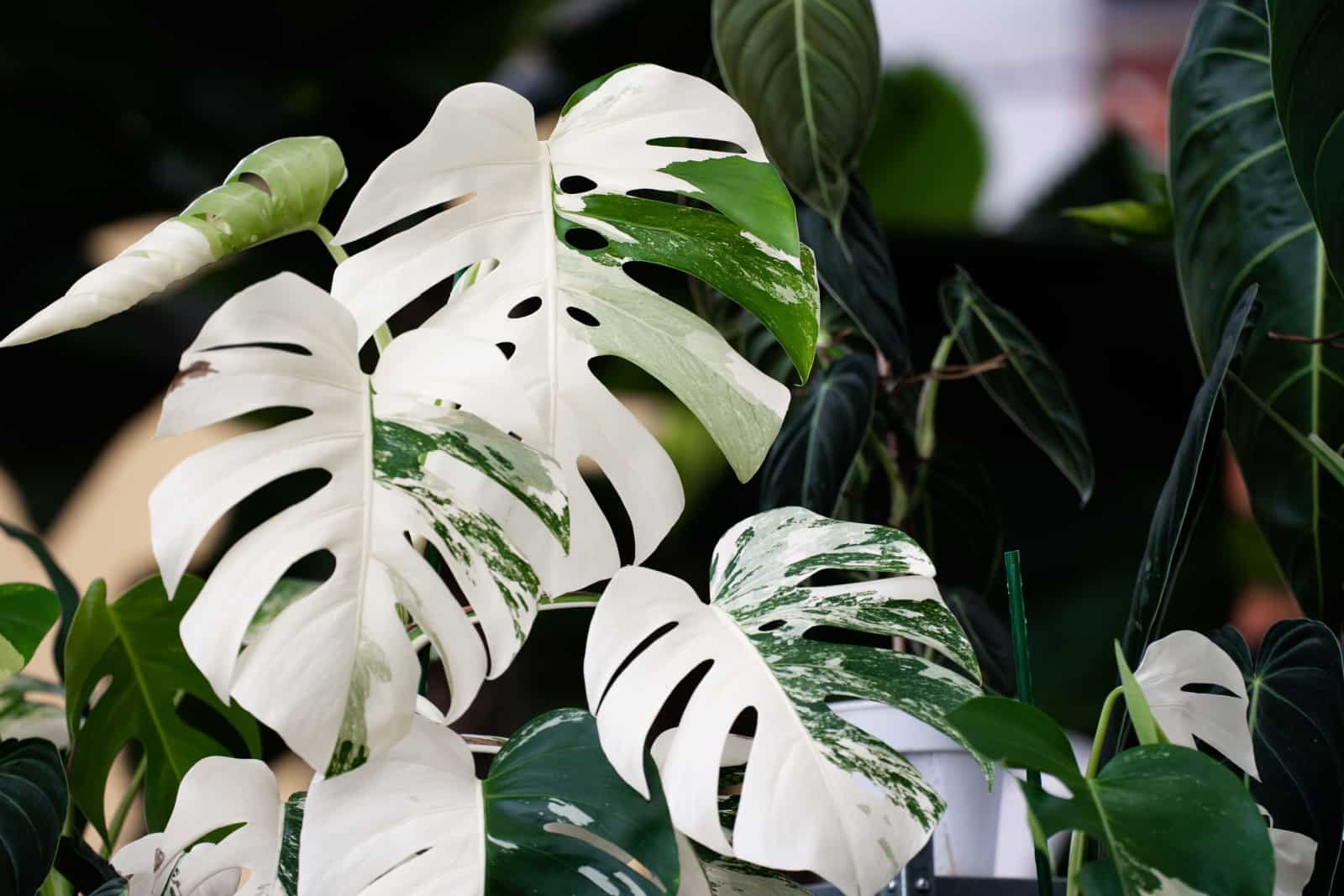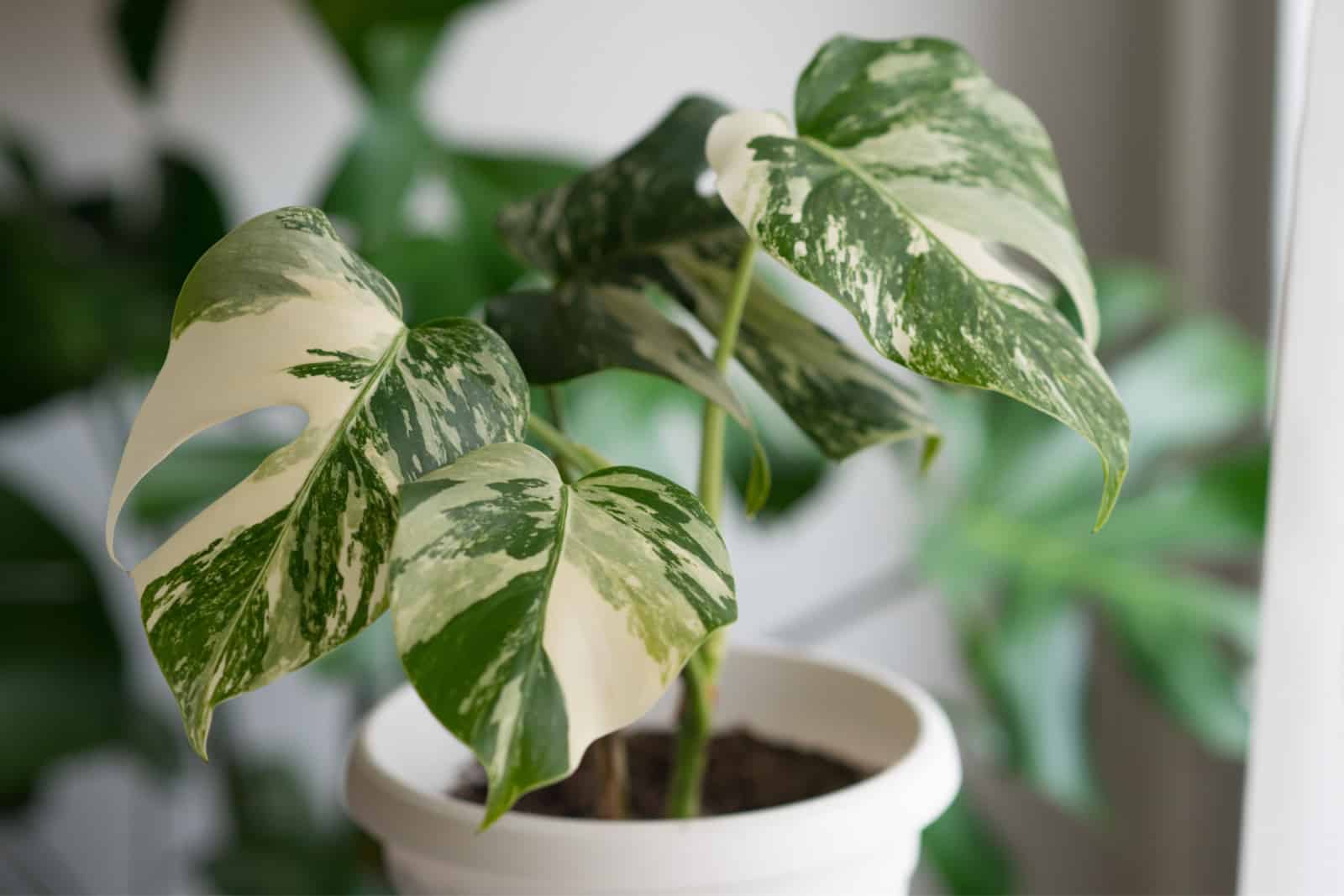Choosing a perfect monstera for your home can be a bit tricky because there are so many varieties out there. But if you have to start with one, I’d recommend a variegated variety.
You can choose a plant with larger or smaller leaves, marbled or clean colors, that’s fenestrated or unfenestrated, etc.
My personal favorite is definitely the monstera albo, and that’s what we’re going to talk about today. This plant has a couple of different variegations, and I’ll mention them at the end of this article.
Before that, we’ll talk about its basic care and some problems that may occur, especially because it isn’t cheap.
Here is its basic information:
Monstera Albo Care
The basic monstera plant care guide tells us that these species require indirect sunlight, some water and humidity, warm temperatures, and a fast-draining soil.
But if you want your plant to truly shine, you’ll need to learn a couple of things about its feeding schedule and its repotting, cleaning and pruning needs.
Don’t worry, I’ll tell you all about those things shortly.
Light Requirements
If you want to avoid dealing with a leggy monstera, the best thing you can do is provide it with ample sunlight. Low light levels will result in etiolated plants with an unsightly appearance. (1)
Therefore, you must ensure your monstera albo gets bright indirect light for most of the day. Keeping it in an east or south-facing corner of your home will achieve just that.
A Monstera Albo that gets sufficient sunlight will exhibit lots of striking variegation. However, it cannot handle direct sunlight, especially throughout the hot afternoons.
That’s why west-facing windowsills aren’t the best option for this species; however, If you only have room there, move your plant 2-3 feet away from it so that the direct sun rays don’t reach its foliage.
Water And Humidity
This tropical plant loves moisture, but you shouldn’t keep its roots wet all the time.
The best watering advice I can give you is to wait until the top few inches of the substrate are dry before irrigating it.
This way, you’ll avoid overwatering and root rot but still keep your green buddy hydrated.
Watering frequency depends on other growing conditions such as temperature, soil mix, and humidity.
You should also reduce watering during the winter months because that’s when this plant usually enters dormancy. At this point the soil will dry out slower, but if you check it regularly you won’t have issues with this.
Finally, remember to use water without chlorine or fluoride since they can build up in your plant. You can use distilled or rainwater, and if you don’t have access to these, consider getting a filter.
If you’re out of options, you can always pour tap water into a watering can and let it sit in the air for at least 24 hours before using it. This will allow the chlorine to evaporate.
Humidity
Monsteras love humidity and the same goes for your albo. You should keep the indoor air moisture level at 60% or above so that this plant can truly thrive.
The best way to achieve this is by getting a humidifier. Humidity trays can’t raise humidity levels that much, so you’ll have to mist your plants frequently.
You can try grouping it with other plants with similar air moisture needs, or moving it to a bathroom or kitchen because they’re usually the most humid rooms. However, if you notice brown tips and crispy leaves, you should get a humidifier.
Temperature
The best temperatures for the monstera albo are between 65 and 75 degrees Fahrenheit. However, it can tolerate a slightly wider range than this.
This species can survive in temperatures down to 55 degrees, although its growth rate will be significantly slowed. If it gets any cooler than that, below 50 degrees, for example, the plant can suffer from cold shock and even die.
When it comes to conditions on the higher end of the temperature spectrum, this plant can grow perfectly well up to 86 degrees Fahrenheit, but everything below that will stress it out. You’ll also have to water it more frequently in warmer conditions.
I know from personal experience that you should keep it away from drafty locations such as near ACs, heaters, old windows, etc. When I got my first albo, I accidentally placed it near a heater and it soon started deteriorating.
That’s because these locations can dry out the air and cause temperature swings, which stress your plant.
Soil And Fertilizer
The best monstera soil mix is loose, aerated, and well-draining with a pH between 5.5-7.0.
The good news is that there are plenty of these products on the market, so you don’t have to get your hands dirty if you don’t want to.
However, if you want to make your own monstera potting soil, you’ll have to use moisture-retentive and well-draining materials.
For my albo, I love to keep things simple. I add equal parts coco coir, perlite, pumice, and orchid bark. If you don’t have coir, you can substitute it with peat moss or even regular potting soil.
Fertilizer
This tropical plant isn’t a heavy feeder, so you don’t have to fertilize it that frequently.
However, it does require nutrients for optimal growth and variegation, so you should feed your monstera albo with a well-balanced fertilizer such as triple 20 once a month.
If you notice that your plant responds well to feeding, you can increase the frequency to twice a month during its growing season, but not more often than that.
Don’t forget to dilute the fertilizer to half-strength since high nutrient concentration can damage plant roots.
Don’t fertilize it in winter. The albo enters dormancy in those months and has no need for additional minerals.
Repotting
What I love about monsteras is that they don’t grow very fast, so you only need to repot them every 2-3 years, including this one.
Of course, the best way to tell whether your plant needs repotting is by examining it. If you notice that the roots are coming out through the drainage holes, it’s a sure sign that you need to move it to a larger planter.
Get a container 1-2 sizes larger than the previous one and place some growing medium in it.
Repotting monsteras isn’t as easy as it seems because we usually grow them on moss poles. But if you have a friend to help you out, then one of you can keep the pole and the plant safe while the other is getting it out of its planter.
Once that’s all finished, you can move it to its new home together with the moss pole.
Finally, the best time for repotting is during the plant’s growing season (so spring and summer). You can also do it in the winter, but the plant will have a much harder time adjusting to the new container.
With an expensive plant like the albo, I wouldn’t risk it!
Here are some more helpful tips for moving your monstera albo to a new planter:
Cleaning And Pruning
Cleaning monstera leaves is an important part of their care routine because it removes the dust layer and allows them to photosynthesize properly.
I like to do this by damping a microfiber cloth and wiping the foliage with it. I do this whenever I notice dust on my plants, but not more frequently than once a week.
You can also use olive oil or add a drop of dish soap, but I just find it tedious as you have to wipe or shower your plant to remove all the residue.
Pruning
What I love about these plants is that they don’t require regular pruning. Of course, you should remove old, yellow, and diseased leaves since they only drain energy.
I’m also not a fan of aerial roots, so I trim them once they grow too long for my taste. However, you don’t have to do this since it doesn’t affect the plant’s health in any way. You can also divert them to grow into the container.
Propagation
The easiest way to propagate this plant is by stem cuttings, so I’ll discuss this method in more detail.
Step 1. Take a healthy 6-inch cutting with at least one node and some aerial roots (although, they’re not necessary).
Step 2. If your cutting has more than one leaf, remove the bottommost ones to expose more nodes and increase the chance of rooting.
Step 3. Place the monstera cutting in a moist seed-starting mix, LECA pebbles, or water. Each medium works great, but if you choose water or LECA, remember to replace the liquid every week or whenever it gets murky. Ensure that the nodes are in the substrate but the leaves are not.
Step 4. Expose your monstera to bright indirect sun and warm temperatures. If you’ve decided to propagate in a seed-starting mix, keep it moist all the time but never dripping wet.
Step 5. It’ll take some time for the root system to develop, but when it does, you can transfer your plant into a small pot. I usually wait until the roots are 2-3 inches long and no longer transparent.
Step 6. After transplanting your cutting, keep the potting medium damp for the next couple of weeks so that it can acclimate. Afterwards, you can care for it as you would a mature plant.
Common Issues
Common monstera problems include leaf discoloration, pests, and diseases such as root rot.
Your albo can suffer from these same issues, but you’ll be glad to hear that you can avoid them by caring for your plant properly.
And if something does happen, here’s how to solve it!
Pests
The most common nuisances that invade this plant are mealybugs, spider mites, aphids, thrips, and scales.
If you notice these bugs or signs of them such as webs, sticky stuff, and small brown spots, you should take your albo monstera away from your other houseplants. This will prevent the infestation from spreading.
If there are just a couple of bugs on it, you can remove them by hand or with a cotton pad soaked in rubbing alcohol. If the infestation is severe, then horticultural oils and insecticidal soaps are your best chance of defeating it.
Diseases
The most common infection that afflicts this tropical beauty is root rot, and we cause it by overwatering our plants.
The usual signs of monstera root rot include wilting and yellow leaves, slow or non-existent growth, and an unpleasant smell spreading from the pot.
Once you expose the plant’s roots, you’ll notice that they are soft, soggy, mushy, and dark if they’re suffering from this infection.
Your best chance of fighting this disease is by removing the infected parts. Afterwards, spray some broad-spectrum fungicide on the remaining ones and repot your plant into a fresh potting mix and clean container.
Leaf Discolorations
The usual monstera albo discolorations include yellowing, browning, or pale foliage.
If you notice that your plant’s leaves are yellow, it could be a sign of overwatering and root rot. If this is the case, cease irrigation and remove the infected roots before repotting into clean soil and a new or disinfected planter.
Yellow leaves can also mean that your plant isn’t getting enough nitrogen. Think about when the last time you fed your plant was, test the soil, and add more of this nutrient if needed.
Pale or yellow leaves may indicate that your albo monstera isn’t getting enough sunlight, which is usually followed by a leggy appearance. If this happens, gradually move your plant to a location with bright indirect light.
Brown tips and margins occur when your plant is underwatered or you keep it in low humidity. Check the growing medium for moisture and, if it’s damp, increase the humidity levels by misting or using a humidifier.
Finally, large brown patches indicate that your albo is sunburnt. In this case, you should move it to a more secluded area and try not to expose it to direct sunlight. Or at least minimize the sun exposure to morning or late afternoon.
When we think of the “monstera albo” we’re usually referring to plants with white variegations from this genus.
And there are a couple of different patterns they may have, which I’ll describe now!
Monstera Albo White Tiger
The white tiger has marbled and half moon variegations, but it has much more white coloring than the marbled half moon varieties.
It also has separated leaves with plenty of fenestrations, bearing that classic Monstera deliciosa look.
This species is quite expensive, but you can get its cuttings on Amazon and grow one yourself:
Sport Monstera
This variety doesn’t have many white variegations, especially when we compare it to other species on this list.
However, it can have just one small patch of white or, more commonly, yellowish-green shades on a deeper green surface.
This is what makes it much cheaper than other types, which isn’t that bad. And you can even find it among regular non-variegated monsteras as it may not display its variegation until it grows up.
This can help you get it for even less money!
Half Moon
The Half moon is one of the most popular variegations and is also called sectoral. Monsteras with these colors usually have half deep green, half white leaves, hence the name.
It also has a white line along its stem, which makes the variegation even more eye-catching.
You can get one here if you’ve fallen in love with this beautiful plant:
Marbled Albo
Marbled albo monsteras are my favorite because their speckled variegations cover the entire leaves.
It also depends on the variety you have, but if you have a small form borsigiana, it’ll usually develop full foliage. However, it can have fenestrations and sectoral leaves, and surprise you with that aspect.
Marbled Half Moon
If you can’t decide whether to get a half moon or marbled albo monstera, why not get a variety that combines them both.
The marbled half moon has freckled variegations on a green surface, accompanied by large white patches on the opposite side.
If you want one, you can try ordering it on Amazon:
Here’s some more info on various albo monstera types:
Final Thoughts
Now you know everything you need to know about caring for the monstera albo and dealing with its common issues!
I even included a couple of popular varieties based on their variegations so that you can grow your collection.
P.S. They all have the same needs, so you’ll easily be able to take care of your small monstera garden.
Until next time!
References:
1. Widmer, R. E. & Synder, L. C. (1957). Care of House Plants. University of Minnesota, Agricultural Extension Service Bulletin.






